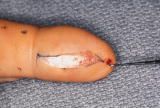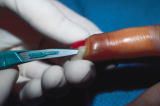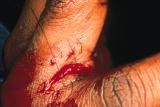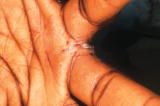- Clinical Technology
- Adult Immunization
- Hepatology
- Pediatric Immunization
- Screening
- Psychiatry
- Allergy
- Women's Health
- Cardiology
- Pediatrics
- Dermatology
- Endocrinology
- Pain Management
- Gastroenterology
- Infectious Disease
- Obesity Medicine
- Rheumatology
- Nephrology
- Neurology
- Pulmonology
Hand Injuries, Part 2:
When you suspect blunt nerve trauma, referral to a hand surgeon is prudent-even without evidence of acute compartment syndrome. The same is true if you discover ischemia in any part of the hand after injury. Try to control hemorrhage with compression and elevation of the involved extremity. If this is unsuccessful, use a short-duration tourniquet. Do not attempt to clamp a bleeding vessel; the risk of causing serious nerve or tendon damage is too high. Avoid exploring wounds in the region distal to the midpalmar crease and proximal to the proximal interphalangeal flexor crease because of the high risk of damaging the flexor tendons and the annular ligaments in this region. Explore more proximal injuries cautiously to determine occult injury to the flexor tendon.
Each year, more than 16 million Americans sustain hand injuries that require emergency care.1 These injuries may involve the nerves, vessels, tendons and ligaments, bones, joints, nail beds, and skin (Figure 1).


Left untreated-or treated improperly-hand injuries may lead to infection and even permanent disability. Consequently, prompt recognition and effective management are crucial (Figure 2).
In the February 2005 issue of CONSULTANT, beginning on page 242, we detailed the general neurologic, vascular, and musculoskeletal evaluation of patients with hand injuries. We also described how to cleanse, anesthetize, and close wounds to minimize the risk of infection.2
Here we turn our attention to the specifics of diagnosing and managing injuries to the nerves, vasculature, tendons, and ligaments of the hand. In an article beginning on page 393 of this issue, we will complete our discussion of hand trauma; our focus will be on management of fractures, dislocations, nail bed injuries, and bite wounds.
NERVE INJURIES
There are 3 distinct categories of nerve injury-neurapraxia, axonotmesis, and neurotmesis. Each is associated with sensory and/or motor nerve deficit; clinical differentiation is based on whether and how quickly nerve function returns.
Neurapraxia results from blunt trauma to a nerve; a transient loss of function occurs, although the integrity of the nerve remains intact. The neurologic deficit usually resolves within 1 to 3 weeks, depending on the severity of the contusion.
Axonotmesis represents axon disruption within a preserved endoneural tube. Wallerian degeneration and subsequent gradual axon regeneration ensue at a rate of 1 to 3 mm per day. The patient eventually recovers full nerve function.
Neurotmesis occurs when all the nerve structures have been damaged. Unless surgical reanastomosis is timely, the loss of function is permanent.
Radial nerve injury. Damage may occur as the radial nerve passes over the dorsum of the wrist. However, injury most frequently occurs proximally and may manifest as an apparent "wrist drop" in which the patient cannot dorsiflex the wrist or demonstrates weakness in wrist dorsiflexion. This finding may also accompany fractures and acute or chronic compression injuries. Regardless of the cause, sensory deficits, paresthesias, and motor dysfunction may be seen in the radial nerve distribution.
Median nerve injury. Lying between the flexor carpi radialis and palmaris longus tendons on the volar surface of the wrist, the median nerve supplies sensation to the radial aspect of the palm and to the palmar surfaces of the thumb, index and long fingers, and radial half of the ring finger. Deficits in median nerve sensory function must be specifically sought, since there is almost complete overlapping from the other nerve distributions. However, sensation to the tips of the thumb and index finger is provided only by the median nerve. Therefore, examine these regions when testing sensory function of the median nerve.
Several possible traumatic causes for acute symptoms of median nerve damage exist; these include wrist fractures, crush injuries, hemorrhage within the flexor retinaculum, burn injuries, and vigorous hand exercises. More often, repetitive motions with the fingers held in flexion and the wrist held in extension-such as typing, driving, and piano playing-lead to chronic symptoms, including numbness, tingling, and burning pain in the tips of the index and middle fingers and of the thumb (carpal tunnel syndrome).
Neurologic examination typically reveals isolated thenar atrophy and the Tinel sign and/or Phalen maneuver. The Tinel sign refers to paresthesias produced along the median nerve distribution in response to percussion of the median nerve at the center of the volar aspect of the wrist. The Phalen maneuver pertains to paresthesias generated when the patient holds his or her hand in full flexion for 60 seconds.
Ulnar nerve injury. The ulnar nerve lies radial to the flexor carpi ulnaris as it passes along the volar surface of the wrist. Because of its proximity to the ulnar artery, injury to one frequently means injury to both.
Injury to the ulnar nerve produces loss of sensation of the volar and dorsal surfaces of the little finger and of at least the ulnar half of the ring finger. The associated motor loss varies little from patient to patient, because there is an overlap of only 10% or less with the median nerve distribution. However, the interossei muscles are usually weakened or paralyzed, rendering patients unable to spread their fingers.
Loss of lumbrical function in the ring and little fingers may lead to the classic clawhand deformity in response to ulnar nerve injury. Another indicator of damage to the ulnar nerve is the Froment paper sign-the inability to maintain strong adduction of the distal phalanx of the thumb against the index finger when holding a piece of paper between the two. (A patient with a positive Froment paper sign will also try to compensate by flexing the thumb against the index finger.)
Treatment. Refer to a hand surgeon any patient with suspected blunt trauma to a nerve, even if evidence of compartment syndrome is lacking. If neurologic symptoms do not appear to improve over time, the hand surgeon may elect to explore the injured hand to identify and repair a surgically correctable lesion if present.
In open wounds with obvious direct nerve injury, prompt nerve repair by a hand surgeon is the ideal, although it may be successfully delayed for several weeks. When indicated, standard wound care (including immediate irrigation and suturing) is necessary to prevent infection.
VASCULAR INJURIES
These may be classified as open or closed. Open vascular injuries are often easy to diagnose; the injury is usually accompanied by profuse, active bleeding. However, spasm can occur in a lacerated artery, which may cause minimal active bleeding.

In contrast, closed vascular injuries to the hand present a tremendous diagnostic challenge: without an overlying wound, direct observation is not possible. Furthermore, the symptoms and signs of serious arterial injury or compromise may be subtle in a closed space.
Arterial laceration from a fracture fragment may impair blood flow. Vascular compromise may also follow dislocation, compartment syndrome, or vascular spasm. In addition, blunt trauma may lead to a false aneurysm or thrombosis and subsequent ischemia.
Ischemia in any part of the hand after injury indicates arterial injury or compression. This requires consultation with a hand surgeon and surgical repair in the operating room.
Controlling bleeding. To most effectively control hemorrhage from a hand wound (whether oozing from muscle or arterial bleeding), apply a compression dressing and elevate the extremity. We recommend sterile gauze with an elastic wrap or direct pressure. Although the injury may appear spectacular, rarely is the hemorrhage life-threatening.
If these measures are unsuccessful, we use a short-duration tourniquet-preferably a pneumatic cuff-applied to the arm at slightly greater than the systolic arterial pressure. Be certain to record the start time of tourniquet application. Surgical consultation is in order if bleeding persists. Under no circumstance should you attempt to clamp a bleeding vessel: the attendant risk of catastrophic nerve or tendon damage is unacceptably high.
Palmar arch injury. Involvement of the palmar arch arterial system-a double arterial supply-frequently is difficult to detect clinically. This is because collateral blood flow from the uninjured vessels often prevents ischemia.
You may not be able to see the palmar arches when you examine an open hand wound. An imaginary line drawn from the superior border of the thumb across the volar aspect of the hand can serve as a marker for the superior portion of the superficial palmar arch. Whenever a significant injury overlies the palmar arches, assume that an arterial injury is present and consult with a hand surgeon immediately for possible operative exploration and repair.
Compartment syndrome. When soft tissue swelling in an extremity occurs in a limited space, an intracompartmental pressure elevation may occur that is sufficiently great to restrict arterial blood flow to the tissues in the closed space. The resulting compartment syndrome must be treated promptly, or permanent muscle or nerve impairment may ensue. Irreversible muscle damage may occur as early as 6 to 8 hours after the onset of ischemia.
Factors associated with compartment syndrome are muscle contusion, fractures, gas-forming infection, and toxic envenomations. A conscious patient with compartment syndrome usually complains of severe pain and tenderness in the involved compartment. Findings may include obvious injury or massive tissue edema.
Maintain a high degree of clinical suspicion for compartment syndrome; onset may be delayed, at which point urgent intervention is required. An even higher degree of suspicion is needed when the patient suffers mental status changes and thus cannot communicate or exhibit appropriate discomfort.
If you suspect compartment syndrome, consult with a hand surgeon immediately. The only definitive treatment is fasciotomy in the operating room, since measurement of muscle intracompartment pressure is not physically possible in the hand itself.
"Hand trip." An infrequent but noteworthy mechanism of vascular injury to the hand can result when injection drug users inadvertently inject foreign material from their drug mixture into an artery. Symptoms of a hand trip (as it is known to laypersons) include severe burning and swelling in the fingertips. Physical findings vary according to the physical and pathophysiologic effects of the injected substance and may include blanching, cyanosis, and gangrene of the fingertips.
INJURIES TO THE TENDONS AND LIGAMENTS
Flexor tendon injuries. These are fraught with potential complications, such as injury to the ligamentous pulleys (annular ligaments) that support the tendons, and thus necessitate immediate referral to a hand surgeon. We advise against exploring wounds in the region distal to the midpalmar crease and proximal to the proximal interphalangeal flexor crease, because of the high risk of damaging the flexor tendons and the annular ligaments in this region. This zone is termed "no-man's-land" because of the difficulty in obtaining excellent surgical outcomes in the zone.
More proximal injuries may be cautiously explored to determine occult injury to the flexor tendon that cannot be detected by clinical examination, and to identify retained foreign bodies. There is controversy regarding the need for immediate operative repair of flexor tendon injuries in the hand, but this decision is best left to the hand surgeon.
Extensor tendon injuries. Managed improperly, these may cause loss of hand or finger function; fortunately, management is straightforward. Refer any patient with a suspected extensor tendon injury to a hand surgeon within 3 to 5 days of the accident, whether or not repair was undertaken in the emergency department.
Left untreated, a partially separated extensor tendon may evolve into a complete separation with permanent motor dysfunction. An extensor tendon that is less than 50% lacerated need not be repaired, however. Repair of an extensor tendon that has sustained an acute laceration through more than 50% of its diameter, in a region other than over the proximal interphalangeal joint, may be carried out by a qualified physician in the emergency department.3
With effective wound irrigation, skin closure, and splinting of the joint for 4 to 6 weeks, an extensor tendon that is less than 50% lacerated usually heals completely with full function. An exception is an extensor tendon injured directly over the proximal interphalangeal joint. Have a hand specialist attend to this injury as soon as possible to prevent a boutonnière deformity-flexion of the proximal interphalangeal joints and extension of the distal interphalangeal joint in response to volar displacement of the lateral bands.
Occasionally, the patient loses extensor function to the distal phalanx after an acute injury. The mechanism is usually one of forced flexion that has avulsed the insertion of the extensor tendon from the distal phalanx. Because the patient cannot extend at the distal interphalangeal joint, he maintains the finger in a flexed position, better known as a mallet finger deformity.
Management of a mallet finger deformity requires 6 to 8 weeks of splinting that keeps the distal interphalangeal joint in extension without restricting proximal interphalangeal joint mobility. If there is a coexistent intra-articular fracture, healing may be slowed, so consult with a hand surgeon regarding the suitability of operative repair.
When splinting a hand with an extensor tendon injury, place the hand in a "position of use" or "neutral" position. Specifically, make sure that the wrist is extended approx-imately 30 degrees and that the metacarpophalangeal joints are maintained in slight flexion (30 to 45 degrees) to approximate the natural cascade.4


The natural cascade describes the staggered fingertips when the hand is in its natural, motionless position and all involved voluntary muscles are relaxed. The first and fourth metacarpophalangeal joints flex at approximately 45 and 70 degrees, respectively, while each of the interphalangeal joints flexes at approximately 10 to 15 degrees. Before splinting, pad each interdigital web space with gauze and bandage any lacerations with a protective sterile dressing (Figure 3).
Ligamentous injuries. These are frequently missed. The collateral ligaments that extend across the interphalangeal and metacarpophalangeal joints protect against lateral displacement of these joints. Hence, when these ligaments tear, instability of the joint space may occur, depending on the extent of injury.
To test the collateral ligaments across an interphalangeal joint, place pressure against the phalanx on either side of the joint you are examining; the aim is to open the joint space while the finger is held in extension.4 When testing the collateral ligaments of a metacarpophalangeal joint, be sure that the finger is held in flexion. Digital block anesthesia is often required before the patient can fully cooperate, as outlined in our previous article.2
A joint-space opening of 2 to 3 mm may indicate a mild collateral ligament tear. An opening of more than 3 to 4 mm suggests that a collateral ligament has ruptured and that a volar plate injury also may have occurred.
Ligament ruptures and possible volar plate injuries require splinting and immediate referral to a hand surgeon for possible operative repair. (Recommendations for managing mild ligament strains without evidence of joint instability vary; follow the advice of the hand surgeon regarding immediate motion or immobilization.) When splinting these injuries, flex the metacarpophalangeal joints at 45 to 50 degrees and keep the interphalangeal joints in a neutral position.
Chronic weakening and subsequent instability of the ulnar collateral ligament of the thumb causes gamekeeper's thumb. This injury leads to lateral instability and dislocations of the metacarpophalangeal joint. Use of a thumb spica splint or cast and immediate referral to a hand surgeon are indicated.
References:
REFERENCES:
1.
Markovick VJ, Pons PT, Wolfe RE.
Emergency Medicine Secrets
. Philadelphia: Hanley & Belfus, Inc; 1993.
2.
Brandenburg MA, Hawkins L, Quick G. Hand injuries, part 1: evaluation and wound care.
Consultant
. 2005;45:242-254.
3.
Trott A.
Wounds and Lacerations
. St Louis: Mosby–Year Book Inc; 1991.
4.
Simon RR, Koenigsknecht SJ.
Emergency Orthopedics
. 3rd ed. Norwalk, Conn: Appleton & Lange; 1995.
